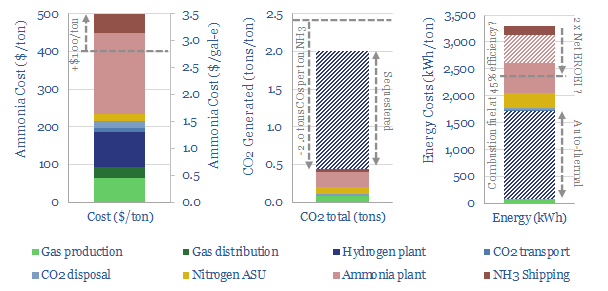Blue ammonia can economically decarbonize the fertilizer industry, using low-cost natural gas; with options to decarbonize combustion fuels in the future. This 12-page report covers where we see the best opportunities, as reforms to the 45Q have already kick-started a 20MTpa boom of new US projects.
The pathway to producing blue ammonia is technically ready, scalable, and has just received an enormous boost, as reformed US 45Q regulation offers $85 per ton of CO2 that is captured and sequestered. This report argues blue NH3 can economically decarbonize the global fertilizer industry, with possible options to decarbonize some fuels in the future.
The end-to-end value chain is described on pages 2-3, aggregating across our models of gas production, gas distribution, hydrogen production, nitrogen production, ammonia synthesis, CO2 transportation, CO2 disposal and ammonia shipping. Hence we can estimate the costs (in $/ton), CO2 intensity (tons/ton) and energy costs (kWh/ton).
Option #1 for blue ammonia is to sell this feedstock, and its derivatives, into a growing global fertilizer market. This is our favorite option, for reasons outlined on pages 4-5.
Option #2 for blue ammonia is to blend NH3 into existing burners and boilers. There is no CO2 released when NH3 is burned, but there is CO2 embedded in the production and distribution of blue ammonia. CO2 abatement costs are calculated versus oil products, coal, gas and LNG on page 6. We argue this is more of an “option” than a mass-scale decarbonization opportunity, fit for specific contexts, at specific times, per page 7.
Option #3 for blue ammonia is to displace other liquid fuels, especially as a marine fuel. We think this option is going to be more challenging, and slower to emerge, for the reasons on page 8.
Darker thoughts. The net EROEI of the global energy system has risen steadily for 300-years, to current levels around 28x, per our note here. From an EROEI perspective, investing $50bn into producing blue ammonia does not allay our fears over mounting global energy shortages (pages 9-10).
Where are the best projects? We have screened a 30MTpa global pipeline of blue ammonia projects. We propose five rules of thumb to identify the best projects (page 11). And we also discuss some leading examples from our database, including the underlying companies, both project sponsors, services, and technology providers (page 12).
